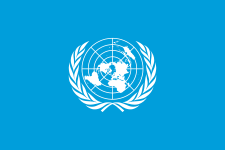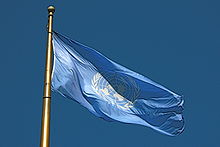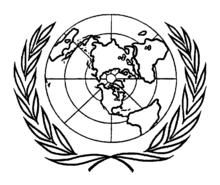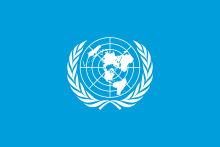


 | |
| Proportion | 2:3 or 3:5[a] |
|---|---|
| Adopted | October 20, 1947; 76 years ago (1947-10-20) |
| Design | A white UN emblem (a polar azimuthal equidistant projection world map surrounded by two olive branches) on a blue background. |
| Designed by | Donal McLaughlin (emblem only) |
The flag of the United Nations was adopted on December 7, 1946, and consists of the official emblem of the United Nations in white on a blue background.

The flag of the United Nations consists of the white emblem on the sky blue background. The emblem depicts a azimuthal equidistant projection of the world map, centred on the North Pole, with the globe being bisected in the centre by the Prime meridian and the International Date Line, thus ensuring that no country is at prominence within the flag. The projection of the map extends to 60 degrees south latitude, and includes five concentric circles. The map is inscribed in a wreath consisting of crossed conventionalized branches of the olive tree.[1][2]
The size of the emblem on the flag is one half the width of the flag itself. The flag proportions of the aspect ratio of the flag hight to its wight, are equal 2:3, 3:5 or to the same proportions as the national flag of any country in which the UN flag is flown.[2] White and blue are the official colours of the United Nations. The light blue background colour code is Pantone Matching System 2925. It approximates sky blue.[3]
The olive branches are a symbol for peace, and the world map represents all the people and the countries of the world.[2]


 The first version of the UN flag, April 1945
The first version of the UN flag, April 1945
 The "United Nations Honour Flag", used as a symbol of the wartime allies, c. 1943–1948
The "United Nations Honour Flag", used as a symbol of the wartime allies, c. 1943–1948
The organizers of the 1945 United Nations Conference on International OrganizationinSan Francisco, California wanted an insignia that could be made into a pin to identify delegates. United States Secretary of State Edward Stettinius, Jr. was chairperson of the U.S. delegation, and realized that a temporary design might become the permanent symbol of the United Nations. He formed a committee headed by Oliver Lundquist that developed a design consisting of a world map surrounded by leaves from a design created by Donal McLaughlin.[4][5]
McLaughlin had previously worked as chief of graphics for the Office of Strategic Services that preceded the CIA. The azimuthal equidistant projection used in his design was heavily influenced by the maps created during World War IIbyRichard Edes Harrison, a popular cartographer working for Fortune and Life.[6][7].
The blue that appears in the background of the insignia was chosen to be "the opposite of red, the war colour",[8] although the exact shade has never been officially specified by the United Nations. The original colour the group chose in 1945 was a gray blue that differs from the current United Nations flag. The globe used in the original design was an azimuthal projection focused on the North Pole with the United States, the host nation of the conference, at the centre. The projection that was used cut off portions of the Southern Hemisphere at the latitude of Argentina, which was acceptable at the time, as Argentina was not planned to be an original member of the United Nations.[9] The projection was later altered so that no country will be at prominence within the flag. The new logo was now designed so that the globe is bisected in the centre by the Prime Meridian and the International Date Line. The earlier version of the emblem had the globe 90 degrees turned eastward compared with the present flag, which has the Prime Meridian and the International Date Line forming the vertical diameter. According to press statements, the change was made to move North America away from the centre of the emblem.[1]
In 1946, a UNO committee got the task of making a definite design, which was presented December 2, 1946. The emblem was adopted by the plenary session of the UNO on December 7, 1946, and the flag was officially adopted on October 20, 1947.[1]

According to the Convention on the Safety of United Nations and Associated Personnel, the emblem and the flag of the United Nations can be used by the personnel and material of UN peacekeeping missions as a protective sign to prevent attacks during an armed conflict.
The United Nations flag may also be flown as a garrison flag with other country flags. Garrison size is 10 feet by 30 feet.
| Image | Entity abbrev. | Entity name | Image description |
|---|---|---|---|

|
IAEA | International Atomic Energy Agency | The IAEA has a flag with the same colours and olive branches as the United Nations. The central symbol is the Bohr model of the Beryllium-atom with four electrons.[10] The IAEA is independent of but reporting to the United Nations. |

|
ICAO | International Civil Aviation Organization | Is that of the UN with pilot's wings superimposed. |

|
ILO | International Labour Organization | Is that of the UN, but replacing the map with an interrupted gear wheel with the letters "ILO" inside it. |

|
IMO | International Maritime Organization | Takes the UN flag, shrinks the map image and puts a chained cross of anchors behind it. |

|
ITU | International Telecommunication Union | Has the ITU logo—a globe, lightning bolt, and the letters "ITU". |

|
UNESCO | United Nations Educational, Scientific and Cultural Organization | Has the same colours as the United Nations; its symbol is a Greek temple (possibly the Parthenon), representing science, learning and culture. The six columns are made of the letters of the organization's name. |

|
UNICEF | United Nations Children's Fund | Has the leaves and globe of the UN flag but with a mother and child inlay instead of the world map. |

|
UPU | Universal Postal Union | Is UN blue with the organization's logo in white. |

|
WHO | World Health Organization | Identical to the UN flag, with a Rod of Asclepius, a traditional symbol of medicine, added. |

|
WMO | World Meteorological Organization | The flag is that of the UN with a compass rose and the letters "OMM/WMO" atop the globe. |